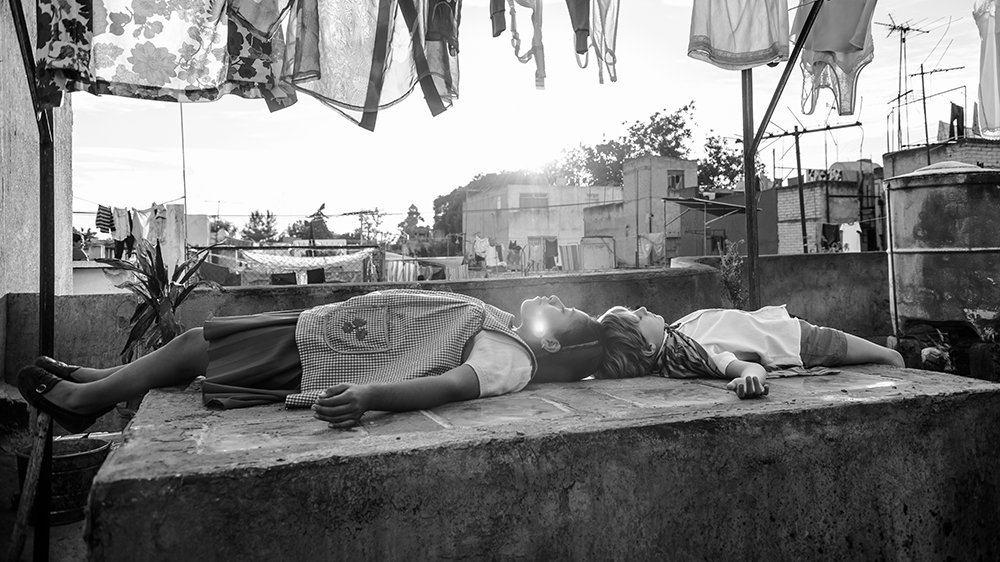
NYFF Review: ‘Roma’ is essential viewing
Written by: Lauren Humphries-Brooks, CC2K Staff Writer
Alfonso Cuarón’s latest film Roma is a difficult movie to write about. There is no overarching arc to speak of, and the film spends much of its runtime creating a sense of familial, class, ethnic, and social relationships, rather than concerning itself with developing plot. But Roma is an engrossing experience, as Cuarón utilizes every inch of the frame to craft a story about loving, melancholic memory untinged with nostalgia.
Roma is a slice-of-life narrative about the relationships within an upper middle class Mexican family and their housekeeper/nanny, living in the Roma district of Mexico City in 1971. Cleo (Yalitza Aparicio) lives in the home of doctor Antonio (Fernando Grediaga) and wife Sofia (Marina de Tavira), where she cooks, cleans, and takes care of the four children. Though treated as a servant, she acts a surrogate mother to the children. She’s defined as one thing at home, another in her existence outside the family milieu. When there is upheaval within the domestic sphere, there is also upheaval without, setting Roma against the backdrop of political rebellion and the 1971 student massacre in Mexico City. But while politics influences some of the film’s events, the focus is on the nature of memory, the relationships within the family, and the experience of women and class within Mexican society.
Roma is a story with no absolute center. This is the drama of everyday life, varied and variegated, that involves both class conflict and a familial attachment that transcends class. Cleo is treated as one of the family, but she is also treated as an employee—one scene has the grandmother confessing that she doesn’t know Cleo’s last name or whether she has any immediate family. This dichotomy—that Cleo is both an employee, and someone who acts as a surrogate parent to the children and a friend to Sofi—is never fully interrogated. There is no clear political or social criticism here, which is both the film’s strength and weakness, for it feels as though any acknowledgement of the class divide is subsumed under the sense of familial attachment. This comes into play in the use of language; Cleo and the other servants speak a combination of Mixtec and Spanish, the family only Spanish, emphasizing Cleo’s inherent separation from the life of the family. She is both one of them and not, someone who is beloved but who also exists outside the walls of the house, a separation that will dwindle and, visually at least, disappear by the end of the film.
Crisis strikes in the heart of the family, resulting in a defined split between the public and domestic sphere in which Sofi and the children increasingly rely on Cleo for emotional support. Cleo, in her turn, needs the attention and support of other women to guide and protect her against the callousness of the external, male world, making it clear that the public/domestic split is also a gendered one. Antonio, hardly seen for much of the film’s runtime, is a distant figure whose behavior nevertheless defines the world for his wife and children; Fermin, Cleo’s boyfriend, becomes another barely seen yet ever-present antagonist, the two men together forming a masculine threat to the union of women and children within the domestic sphere. The internal, domestic, female world includes children of both genders, who are shielded from the behavior of the men around them, and who depend on the care and attention of the women to sustain them. Cleo’s personal crisis acts in concert with the crisis of the family, and those in the domestic sphere unite to protect and support each other from the violent, external, masculine world.
Mexico, city and countryside, is as much a character as the characters themselves, informing their lives, shaping their experiences as they take part in sweeping political and social moments that are rendered intensely personal through the characters’ eyes. Visually, Roma appears austere at first, filmed in black and white with an extensive grayscale palette. But the ultimate result is not austerity, nor is it a nostalgic throwback. Cuarón populates each scene with a richness of detail, meticulously crafting a varied mis en scene that is both loving and realistic. Mexico City, and Roma in particular, in rendered in gorgeous detail, seen through the eyes of the women and children who move through it. The same is true for when the film moves farther afield, to the countryside where the family will spend New Year’s, and finally to the seaside for the denouement. The visual nature of the narrative expands upon the family’s conflicts and crises, an interaction of nature, emotion, and human experience.
There is a sweeping richness to Roma that never descends into nostalgia for “a better time,” but rather recognizes the heartache, the pain, and the joy that was a part of the past. Roma is about memory, not fragmented and venerated, but realized with all its imperfections. As well as being an essential viewing experience, this is probably Cuarón’s greatest film to date.
